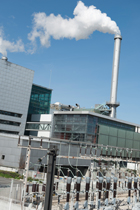- Energy Recovery Home
- Basic Information
- Waste Management Hierarchy
- Related Regulations
- Frequent Questions
- Additional Information
Energy Recovery from Waste
Energy recovery from waste is the conversion of non-recyclable waste materials into useable heat, electricity, or fuel through a variety of processes, including combustion, gasification, pyrolization, anaerobic digestion, and landfill gas (LFG) recovery. This process is often called waste-to-energy (WTE).

Energy recovery from waste is part of the non-hazardous waste management hierarchy. Converting non-recyclable waste materials into electricity and heat generates a renewable1 energy source and reduces carbon emissions by offsetting the need for energy from fossil sources and reduces methane generation from landfills.
1 Defined as separated yard waste or food waste, including recycled cooking and trap grease, and materials described in §80.1426(f)(5)(i). Final regulations allow separated municipal solid waste (after all recyclable materials have been removed) to qualify as "separated yard or food waste.
Currently there are 86 facilities in the United States for combustion of municipal solid waste (MSW), with energy recovery. These facilities are located in 25 states, mainly in the Northeast. No new plants have been built in the US since 1995, but some plants have expanded to handle additional waste and create more energy. The 86 facilities have the capacity to produce 2,720 megawatts of power per year by processing more than 28 million tons of waste per year. According to Municipal Solid Waste in the US: Facts and Figures, in 2011 we combusted about 29 million tons of MSW (about 12 percent) for energy recovery. After energy is recovered, approximately ten percent of the volume remains as ash. This ash is generally sent to a landfill. Please visit EPA’s Landfill Methane Outreach Program for additional information on how energy is recovered from landfills.
This site provides information on the following topics:
- Basic Information on MSW Combustion with Energy Recovery – history, economics, technologies and process
- Non-Hazardous Waste Management Hierarchy – the different management options for the disposal of non-hazardous waste
- Related Regulations – rules and regulations that encourage energy recovery
- Frequent Questions – frequently asked questions
- Additional Information – air emissions, international energy recovery activities, location of WTE plants, flow control and municipal solid waste
- Municipal Solid Waste Decision Support Tool

![[logo] US EPA](../gif/logo_epaseal.gif)